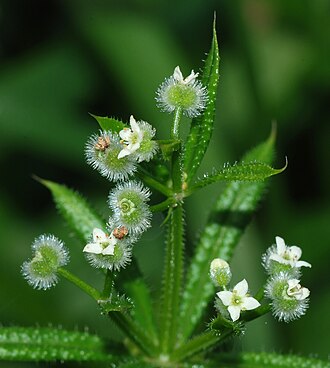Difference between revisions of "Translations:AY Honors/Agriculture/Answer Key/19/en"
From Pathfinder Wiki
(Importing a new version from external source) |
(Importing a new version from external source) |
||
| Line 7: | Line 7: | ||
| description = | | description = | ||
The long stems of this climbing plant sprawl over the ground and other plants, reaching heights of 1-1.5 m, occasionally 2 m. The leaves are simple and borne in whorls of six to eight. Both leaves and stem have fine hairs tipped with tiny hooks, making them cling to clothes and fur much like velcro. The white to greenish flowers are 2-3 mm across, with four petals. | The long stems of this climbing plant sprawl over the ground and other plants, reaching heights of 1-1.5 m, occasionally 2 m. The leaves are simple and borne in whorls of six to eight. Both leaves and stem have fine hairs tipped with tiny hooks, making them cling to clothes and fur much like velcro. The white to greenish flowers are 2-3 mm across, with four petals. | ||
| − | | control = Cleavers, or Bedstraw, tends to grow in uncultivated areas, such as beneath | + | | control = Cleavers, or Bedstraw, tends to grow in uncultivated areas, such as beneath fence lines and at the edges of fields. The main problem it presents to agriculture is that it clogs harvesting machinery. It is best controlled before it is allowed to propagate into cultivated fields by mechanical means, or by livestock. |
}} | }} | ||
Latest revision as of 21:14, 20 May 2021
Galium aparine
| Galium aparine (Cleavers, Bedstraw) | |
|---|---|
|
Where found: Native to North America and Eurasia.
Description: The long stems of this climbing plant sprawl over the ground and other plants, reaching heights of 1-1.5 m, occasionally 2 m. The leaves are simple and borne in whorls of six to eight. Both leaves and stem have fine hairs tipped with tiny hooks, making them cling to clothes and fur much like velcro. The white to greenish flowers are 2-3 mm across, with four petals.
Control: Cleavers, or Bedstraw, tends to grow in uncultivated areas, such as beneath fence lines and at the edges of fields. The main problem it presents to agriculture is that it clogs harvesting machinery. It is best controlled before it is allowed to propagate into cultivated fields by mechanical means, or by livestock.
|
 |
